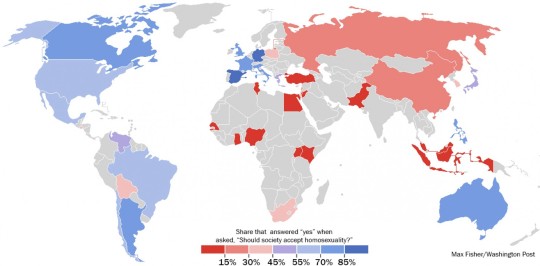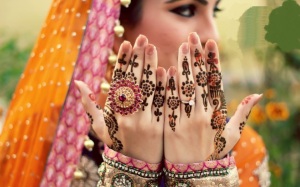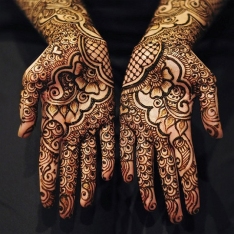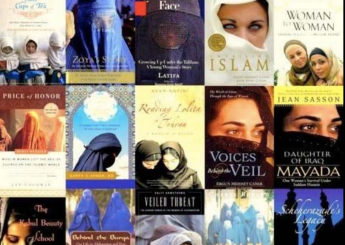In the Middle East, perceptions of “gay” or “homosexual” are different from those of the West, and even Ohio University. Simply going against cultural norms can cause one to be labeled as “gay” in the Middle East; this categorization of homosexuality may be on pure assumption as well. Unlike Western culture, there are many classifications of “gay” in the Middle East, including words that do not have English translations. Another contribution to the mislabel of “gay” can be the lack of distinction between “sex” and “gender”, which, as a communication studies major, I have recently studied extensively. It’s not easy to be gay in any part of the world, but in the Middle East it’s almost like being invisible and at risk at the same time.
Recently, homosexuality has become readily accepted in many countries, including the United States, but in the Middle East it is the excuse for the arbitrary detention, arrest, torture, and deaths of hundreds of people. There are, however, always differing treatments across countries in the Middle East, similar to the U.S.’s state treatments. Israel is often seen as the exception by accepting homosexuality and even allowing “Pride Parades” to occur throughout the country, but many residents of the Middle East have been reported to claim homosexuality is a Western “problem.” They emphasize the differences between Eastern and Western cultures and claim that homosexuality cannot be tolerated. But are we truly that different?
“In Iran, we don’t have homosexuals, like in your country.”
-Iranian President Mahmoud Ahmadinejad (Source)
I identify as a follower of Catholicism, a religion that is seemingly intolerant of homosexuality entirely, and I wondered if Islam followed that stance. Just like Catholicism, Islam is interpreted differently by different followers, but generally its teachings regarding sexuality (homosexual or heterosexual) can be reduced to the importance of procreation and formalized frameworks for sexual activity. Criticisms of homosexuality are generally found in Hadith, history or teachings of the Prophet Muhammad that were passed down orally through history until they were recorded in writing. Many Hadith reports contradict each other, but they include severe condemnations of homosexuality.
The Pew Research Center, as part of a fascinating new report on global attitudes toward homosexuality, asked people in 39 different countries a deceptively straightforward question: “Should society accept homosexuality?” People could answer yes, no or decline the question.
The “yes” answers are mapped out below. In red countries, less than 45 percent of respondents said homosexuality should be accepted by society. In blue countries, more than 55 percent said it should be accepted. Purple countries fall in that middle range of about half. Additionally, as you can see in the line graph, they plotted where a country’s tolerance for homosexuality falls.
However, even with oppressive forces against them, homosexual individuals in the Middle East have found ways to flourish. Beirut’s vitality as a Mediterranean capital of night life has fueled a LGBT scene like any other and in recent years, Lebanon has become one of the most liberal Arab counties when it comes to sexuality and sexual behavior. Also, isolated and secret groups have been known to form to provide support to the LGBT community, despite popular discrimination.
Whether because of politics, religion, or common cultural practices, homosexuals within the Middle East continue to fight for their lives and their right to love. Only with the cessation of these practices and the advocacy of human rights for all people will human beings truly achieve peace. What have we done in Athens to promote a peaceful environment? What cultural values do we show when we are accepting of LGBT identities?
References: The Washington Post, The New York Times, theguardian.com, International Gay & Lesbian Human Rights Commission, Humanitarian News & Analysis, Human Rights & Human Welfare





 or tools from henna kits; all of these make the application easier, but require different skill sets. The paste is also made according to the artist’s skill level – if the paste is thicker, then it is harder to apply and if it is thinner, it is easier. The designs range from simple to intricate in every culture, but can have many distinct differences. Arabic henna designs are usually large, floral patterns on the hands and feet. Indian mehndi involves fine, thin lines for lacy, floral and paisley patterns covering entire hands, forearms, feet and shins. African henna patterns are bold, large geometric designs.
or tools from henna kits; all of these make the application easier, but require different skill sets. The paste is also made according to the artist’s skill level – if the paste is thicker, then it is harder to apply and if it is thinner, it is easier. The designs range from simple to intricate in every culture, but can have many distinct differences. Arabic henna designs are usually large, floral patterns on the hands and feet. Indian mehndi involves fine, thin lines for lacy, floral and paisley patterns covering entire hands, forearms, feet and shins. African henna patterns are bold, large geometric designs. and decorative way. Western societies have also adopted henna as a way to temporarily tattoo oneself (as seen right by the University Program Council at Ohio University) in addition to other methods of self-decoration. What is the cultural implication of henna as used in present day societies? I personally have gone to a party with henna and my friends and I match our henna designs. For me, it’s used as a personal bonding measure between my closest friends. Have you ever tried henna? What’s your favorite design?
and decorative way. Western societies have also adopted henna as a way to temporarily tattoo oneself (as seen right by the University Program Council at Ohio University) in addition to other methods of self-decoration. What is the cultural implication of henna as used in present day societies? I personally have gone to a party with henna and my friends and I match our henna designs. For me, it’s used as a personal bonding measure between my closest friends. Have you ever tried henna? What’s your favorite design?